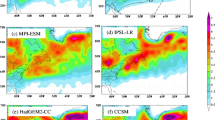Abstract
The lateral motion of the Gulf Stream off the eastern seaboard of the United States during the winter season can act to dramatically enhance the low-level baroclinicity within the coastal zone during periods of offshore cold advection. The ralative close proximity of the Gulf Stream current off the mid-Atlantic coast can result in the rapid and intense destabilization of the marine atmospheric boundary layer directly above and shoreward of the Gulf Stream within this region. This airmass modification period often precedes either wintertime coastal cyclogenesis or the cyclonic re-development of existing mid-latitude cyclones. A climatological study investigating the relationship between the severity of the pre-storm, cold advection period and subsequent cyclogenic intensification was undertaken by Cione et al. in 1993. Findings from this study illustrate that the thermal structure of the continental airmass as well as the position of the Gulf Stream front relative to land during the pre-storm period (i.e., 24–48 h prior to the initial cyclonic intensification) are linked to the observed rate of surface cyclonic deepening for storms that either advected into or initially developed within the Carolina-southeast Virginia offshore coastal zone. It is a major objective of this research to test the potential operational utility of this pre-storm low level baroclinic linkage to subsequent cyclogenesis in an actual National Weather Service (NWS) coastal winter storm forecast setting.
The ability to produce coastal surface cyclone intensity forecasts recently became available to North Carolina State University researchers and NWS forecasters. This statistical forecast guidance utilizes regression relationships derived from a nine-season (January 1982–April 1990), 116-storm study conducted previously. During the period between February 1994 and February 1996, the Atlantic Surface Cyclone Intensification Index (ASCII) was successfully implemented in an operational setting by the NWS at the Raleigh-Durham (RAH) forecast office for 10 winter storms. Analysis of these ASCII forecasts will be presented.
Similar content being viewed by others
References
Cione, J. J., Raman, S., and Pietrafesa, L. J.: 1993 'The Effect of Gulf Stream Induced Baroclinicity on US East Coast Winter Cyclones', Mon. Wea. Rev. 121, 421-430.
Dirks, R. A., Kuettner, J. P., and Moore, J. A.: 1988, 'Genesis of Atlantic Lows Experiment (GALE): An Overview', Bull. Amer. Meteorol. Soc. 69, 147-160.
Fantini, M.: 1991, 'The Influence of Heat and Moisture Fluxes from the Ocean on the Development of Baroclinic Waves', J. Atmos. Sci. 47, 840-855.
Frederiksen, J. S.: 1979, 'The Effects of Long Planetary Waves on the Regions of Cyclogenesis: Linear Theory', J. Atmos. Sci. 36, 195-204.
Pietrafesa, L. J. and Janowitz, G. S.: 1980, 'Lack of Evidence of Southerly Propagating Continental Shelf Waves in Onslo Bay, NC', Geophys. Res. Lett. 7, 113-116.
Riordan, A. J.: 1990, 'Examination of Mesoscale Features of the GALE Coastal Front of 24-25 January 1986', Mon. Wea. Rev. 118, 258-282.
Roebber, P. J.: 1984, 'Statistical Analysis and Updated Climatology of Explosive Cyclones', Mon. Wea. Rev. 112, 1577-1589.
Rogers, E. and Bosart, L. F.: 1986, 'An Investigation of Explosively Deepening Oceanic Cyclones', Mon. Wea. Rev. 114, 702-718.
Sanders, F. J.: 1986, 'Explosive Cyclogenesis in the West Central North Atlantic Ocean, 1981-1984. Part I: Composite Structure and Mean Behavior', Mon. Wea. Rev. 114, 1781-1811.
Sanders, F. J. and Gyakum, J. R.: 1980, 'Synoptic-Dynamic Climatology of the “Bomb”', Mon. Wea. Rev. 108, 1589-1606.
Vukovich, F. M., Dunn, J. W., and Crissman, B. W.: 1990, 'Aspects of the Evolution of the Marine Boundary-Layer During Cold Air Outbreaks Off the South East Coast of the United States', Mon. Wea. Rev. 119, 2252-2278.
Wayland, R. and Raman, S.: 1989, 'Mean and Turbulent Structure of a Baroclinic Marine Boundary-Layer During the 28 January 1986 Cold Air Outbreak (GALE 86)', Boundary-Layer Meteorol. 48, 227-254.
Rights and permissions
About this article
Cite this article
Cione, J., Pietrafes, L.J. The Use of Pre-Storm Boundary-Layer Baroclinicity in Determining and Operationally Implementing the Atlantic Surface Cyclone Intensification Index. Boundary-Layer Meteorology 89, 211–224 (1998). https://doi.org/10.1023/A:1001773019199
Issue Date:
DOI: https://doi.org/10.1023/A:1001773019199




